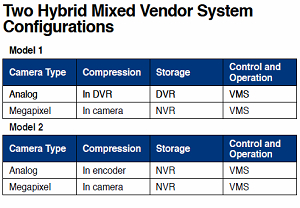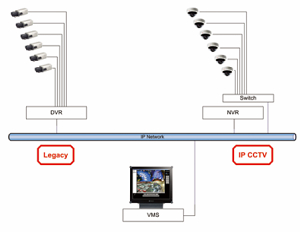One of the most impressive technical feats in designing and implementing video surveillance systems is mixing new technology with old to create fully integrated hybrid systems. In this article, Craig Howie, Commercial Director for Visimetrics, addresses some of issues involved.
One of the most impressive technical feats in designing and implementing video surveillance systems is mixing new technology with old to create fully integrated hybrid systems. In this article, Craig Howie, Commercial Director for Visimetrics, addresses some of issues involved.
Few dare to take on the challenge of designing a solution mixing new and old technology in a fully integrated hybrid video system. Instead, many are skipping around it with excuses of how the technology is incompatible, the existing system is too old to be supported or “new” technology is superior. In fact, just about anything goes but taking on the challenge of integrating legacy and IP video surveillance systems.
So exactly what are the challenges in integrating legacy video to create a true hybrid system? For the purposes of this article, the definition of legacy systems will be based on equipment conforming to PAL/NTSC-based standards. Typically, this would encompass all or some of the following:
● analog cameras
● video matrices
● DVRs
● standard definition (SD) monitors
Compare this with the newer technology of network cameras, video encoders, software matrices, NVRs, video management systems and HD displays.
How do all of these elements function together under that nominal term of “hybrid” system?
Constraints
Regardless of how you wish to integrate legacy with IP systems, the resulting hybrid system will always be subject to the practical constraints of:
● budget
● existing equipment
● existing physical infrastructure
● bandwidth limitations
● video or security management system
● manufacturer cooperation
The options available for each of these constraints will define the optimal course for integrating analog with IP. In practice, we need consider these constraints and work around them, while minimizing risk.
Stepping Away From Video Standards
Bridging analog systems with IP systems is a move away from standards-based systems, such as PAL/NTSC. For the moment, the world of IP video equipment is a land of bespoke systems sharing only the common transmission standard of IP. The actual format of the information passed from camera to recorder or video management system is known only by the equipment manufacturer. This poses a risk for users, as they invest in technology unique to the supplier.
There is some light on the horizon, with standards organisations such as the ONVIF and PSIA. However, the infancy and adoption of both organizations to date means we are still a long way from having defined standards shared by all. Hence, the only practical option is to use the manufacturers' SDKs to provide comprehensive integration for third-party access.
 Mixed Vendor Software Integration
Mixed Vendor Software Integration
SDKs are a set of software tools that allow access between software applications
such as VMS, DVRs or NVRs. SDKs are commonly used by NVRs to integrate network cameras from third-party manufacturers. Conceptually, this seems practical and easy, allowing users to mix and match on individual preference or derived benefit from specific products. This is until the practicality of the commercial world rears its ugly head.
Practicalities such as branded manufacturers choosing to source OEM'ed equipment from different suppliers result in different ranges of equipment from the same manufacturer not working together. Other commercial influences include manufacturers unwilling to provide SDKs due to perceived competitive risks, unsupported SDKs unless covered by licensing royalties, undocumented SDKs or simply SDKs that become antiquated. Most manufacturers never use their own SDK, so it places a burden on them to continually update and support it. This all goes on in the background, usually unknown to the end user who is simply keen to develop his video system.
Hybrid Models
There are a few practical options for hybrid systems, to maximize your existing analog investment. Frankly, there is no image or performance gain when using an SD network camera over an analog camera.
Model 1 makes full use of the existing analog system in its native form. All existing cameras, cabling and recording equipment remain in place. Additional megapixel cameras are added and recorded to an NVR. A VMS would be used for the configuration, control and management of both systems. To the users of the system, the external equipment now seems as one integrated unit.
But there are technical risks. Firstly, there is the integration and capability of the VMS with the DVR and NVR respectively. Secondly, there is also an element of risk in the capability of the integration between the NVR and the network cameras.
Model 2 takes a more wholesale approach. It converts the existing analog system over to hybrid from as close to the analog source as possible, while keeping the original analog cameras. This approach is closer to a true end-to-end IP system, though it doesn't provide any improved performance output over a high quality analog system. It does require additional hardwarecosts, however, for the image conversion to allow for IP transmission from encoder to NVR.
 Moving Forward with Megapixel
Moving Forward with Megapixel
Without doubt, megapixel cameras will become the tipping point towards full adoption of end-to-end IP systems. However, they shouldn't be perceived as the panacea for all until their generic capability is refined and the investment costs become more bearable. Like all video surveillance technology, some implementations are better than others, but one must cite caution on capability, configuration and integration.
Megapixel cameras provide superb tools for post-incident review. They enable much wider fields of view to be achieved than SD cameras are capable. However, they come with higher price tag, not only for the cost of the actual camera, but also needing much higher storage and potentially delivering lower frame rate. Certain applications require the ability to view scenes in real-time or near real-time, such as cash counting or casino tables. Many megapixel cameras simply can't deliver real-time images at the highest resolution yet.
Summary
The application and surveillance requirements should be the deciding factors for use of the most appropriate technology. Key to the advantages of one technology over another must be the information available in one image, when compared against any another.
In wide fields of view overlooking large areas, megapixel cameras can provide extensive amounts of information and detail unavailable from SD cameras. However, for real-time applications having narrow fields of view, SD cameras can provide just as much practical surveillance information.
 Recommendations
Recommendations
If you are considering integrating legacy and IP video systems, the checklist below will help you to ask the right questions.
● Understand the extent of software integration between all of the equipment you have and are considering. Do you have complete control over all configuration and functionality centrally?
● If possible, get a demonstration which allows you to view the full capability of the integration, rather than simple video display.
● Make sure your vendor has an SDK, and that it is maintained and upgraded with backward compatibility. Find out if they use the SDK within their products or solutions.
● Be clear on performance expectations from the hybrid solution. For example, at which point will the system start to slow down from higher bandwidth, storage and processing requirements of megapixel cameras.
● Understand any limitations the solution is confined by, such as the absolute limit of cameras supported or limit of cameras displayed/played back together.
● Be clear who holds responsibility for integration, to ensure “ownership” of any proble